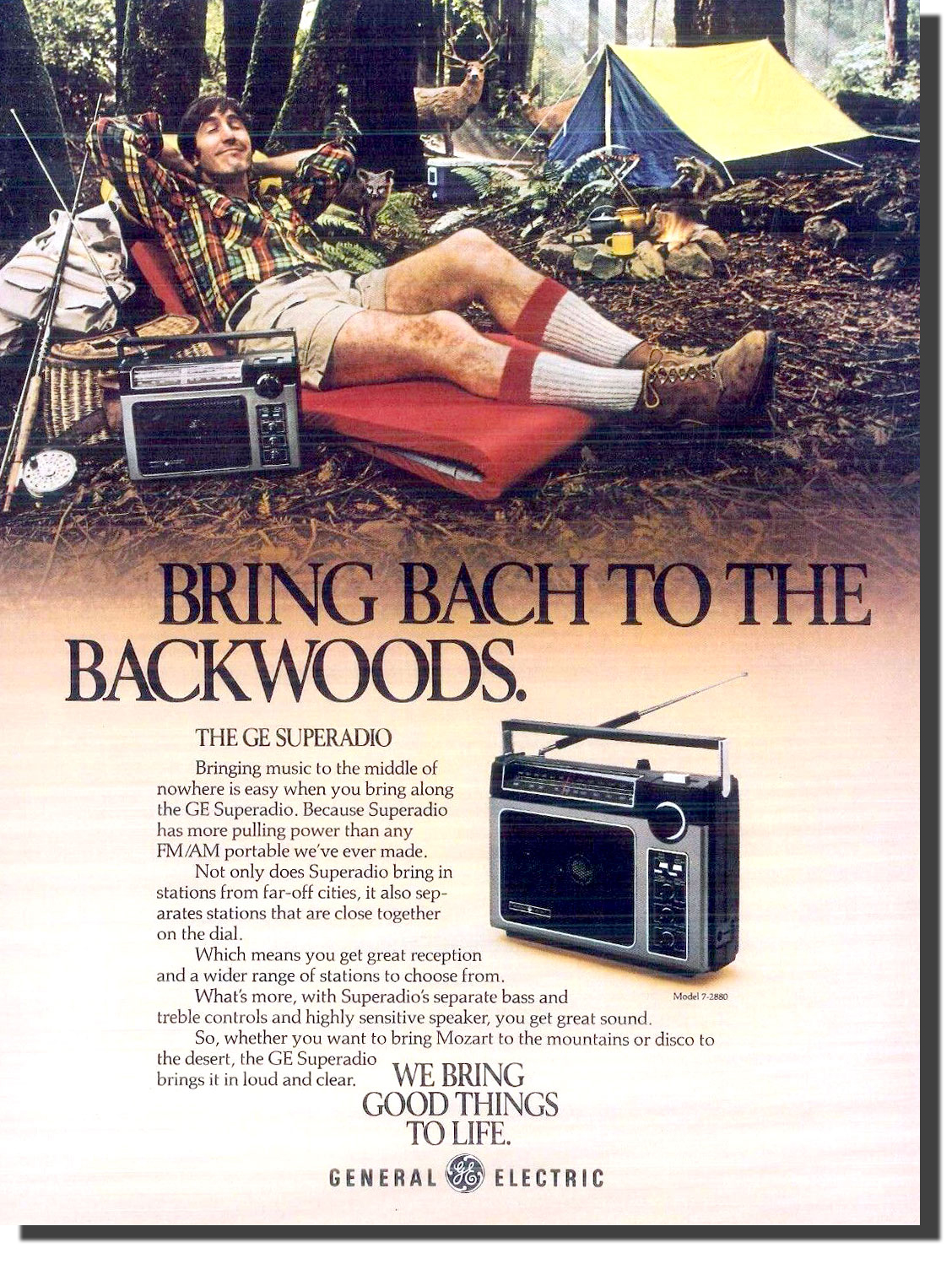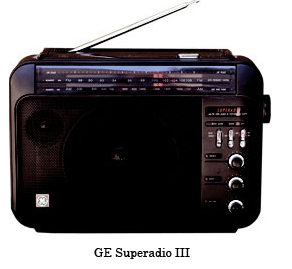 In the mid-90s I had a job that could have been done very well by trained sea lions, and a big pool of us were located in the middle of a huge warehouse-type building about 1/4 mile from any outside wall and window. We all had personal radios or CD players to listen to while we worked, but the radio reception in this building was atrocious. One of my colleagues had a GE Superadio III and it perfomed well even there—so I bought one myself. I let it go when I moved cross-country because I had very limited space and this radio was replacable. I hadn't planned on getting another, but circumstances made it more attractive.
In the mid-90s I had a job that could have been done very well by trained sea lions, and a big pool of us were located in the middle of a huge warehouse-type building about 1/4 mile from any outside wall and window. We all had personal radios or CD players to listen to while we worked, but the radio reception in this building was atrocious. One of my colleagues had a GE Superadio III and it perfomed well even there—so I bought one myself. I let it go when I moved cross-country because I had very limited space and this radio was replacable. I hadn't planned on getting another, but circumstances made it more attractive.
 I've been wanting a radio I could use for emergencies; not the Midland ER310 type where I needed NOAA weather alarms, but something I could use if I'm stuck without power, lightning or a tornado or a North Korean nuke took out the Dog River stations, and I needed the extra sensitivity to pull in signals from The City somewhere out there. I also wanted it to sound good (another knock against the Midland). And I wanted to be able to take it with me if I go glamping or elsewhere, as I didn't want to risk something happening to my Zenith Royal 7000 Trans-Oceanic. This Superadio fit all those criteria nicely.
I've been wanting a radio I could use for emergencies; not the Midland ER310 type where I needed NOAA weather alarms, but something I could use if I'm stuck without power, lightning or a tornado or a North Korean nuke took out the Dog River stations, and I needed the extra sensitivity to pull in signals from The City somewhere out there. I also wanted it to sound good (another knock against the Midland). And I wanted to be able to take it with me if I go glamping or elsewhere, as I didn't want to risk something happening to my Zenith Royal 7000 Trans-Oceanic. This Superadio fit all those criteria nicely.
This page is a placeholder. I don't have one yet. They were still in production when I bought my first one new, but now they are discontinued and take a little digging to find. Superadios have become desirable (particularly the first two models, but even the Superadio III is getting pricey) as budget-priced performance radios. I bought a Superadio II (see below). I may get a I and a III if I come across a helluva deal but I have no burning desire for either right now.
Superadios vs. Others
It's important to note that the Superadios are all AM and FM broadcast only. The Zenith Trans-Oceanics, many C.Cranes, Grundigs, Radio Shacks, and other radios commonly compared against the GE Supers also have shortwave and world band reception. Some include weather and aircraft bands. Supers do not. Their selling point was that they were long-range performance versions of standard AM/FM portable radios without a premium price.
 Differences in the Versions
Differences in the Versions
The original Superadio came out in 1979 as Model 7-2880 (with known A and B variants). It looks like the one in the advertisement here—black and gray, all controls on the front panel.
In 1987 the Superadio II superseded it, Model 7-2885 (with various letters as versions). Cosmetically it's almost identical except for having bare metal knobs rather than black-faced. This model added the tweater so it sounds better in the high sonic frequencies. There are some small changes internally; I don't know whether they improve performance or made the radio cheaper to manufacture—probably some of both. I have seen some models say they were built in Hong Kong, Malaysia, and China.
I have also seen this radio for sale on Etsy with the Pulser brand, but don't know anything about it. My guess is that Pulser is a house-brand for someplace overseas and they were able to sell the radio because GE had no distribution there. But that's speculation.
The Superadio III, Model 7-2887, came out in 1992 and ran through 2008 when the line ended. This was built in China. Thomson Electronics in France had acquired GE's consumer electronics division in the late 80s, and that included RCA (as GE owned RCA at the time). I assume that Thomson ordered the redesign and changed to a manufacturer in China. This is the most common model found these days; it's all black a little brightwork around the switches and knobs. The tuning dial has been shifted from the front to the side, and it's changed to a varactor instead of a tuning capacitor. The typical comments I see say that the long-range performance isn't quite as good as the earlier versions, but it's still a performer. Sound quality, on the other hand, is supposedly improved.
They did add a feature that the earlier versions lacked: AM-wideband. This improved the sound quality of strong AM signals a bit. This could be switched on and off. If improved AM sound quality is important, than the III is the model you want.
The RCA-badged Superadio III. Information on this is very sketchy and nearly everything I know is from observation and speculation. Now Model RP7887. Cosmetically it appears identical to the GE version except for the RCA logos now adorning it. The back panel still has the Thomson Inc. name but the packaging says AVC Multimedia, which may or may not mean anything. Thomson dropped out of the picture some time in the 2000s and the GE/RCA logos are now licensed to various East-Asian enterprises (Wikipedia tries to document who sells what). The general consensus on the internet that I get is that the RCA is the least-regarded of the lot, with a lot of complaints about the build quality. Unfortunately it's almost all heat and no light: I haven't seen any actual side-by-side comparisons with evidence showing that the RCAs are different or worse than the GEs. But they could be. If for some reason I ever get an RCA and a GE, I'll open them up and see if I can tell the differences.
 It does appear that all the Superadios, particularly the III, suffer from poor calibration and tracking of the tuning pointer. That never bothered me because I'm used to old radios where calibration is never precise; and serious radio listeners recommend you use the log hash marks anyway. But still, if you have the skills and the backbone for it, look at Doug's Alignment page (link below) and by all means give it a shot.
It does appear that all the Superadios, particularly the III, suffer from poor calibration and tracking of the tuning pointer. That never bothered me because I'm used to old radios where calibration is never precise; and serious radio listeners recommend you use the log hash marks anyway. But still, if you have the skills and the backbone for it, look at Doug's Alignment page (link below) and by all means give it a shot.
Early Defects and When Was Your Model Made?
Early copies of the Model III had severe sensitivity defects and had to be repaired under warranty. The way to tell when your III was made is to look for a four-digit code in the attery compartment. The second, third and fourth numerals represent the year and fiscal week it was manufactured (the first numeral is the day of the week it was made). If the second number is 2, that meant it was made in 1992. The next two numbers are the fiscal week. So units ending 201 though 241 were initially defective; 242 onward were corrected at the factory. Do you have a 201 through 241? If so, hopefully it was repaired. If not, you're out of luck. I don't know how the year code changed after 2001, please don't ask me.
My Superadio II
Cosmetically it's in good shape. The bright work is flaking off in spots and the knobs look like they've seen better days, but the slide-rule pointer works, the antenna is intact, I haven't found anything broken, and it's got the "headphone capable" sticker still on it (big deal but I am surprised that it has lasted this long). Functionally it works great on AC. I dialed in the local talk radio station that my Midland ER310 struggles with, and it sounded strong and clear on both AM and FM. Haven't tried batteries yet (it needs six D cells and I only have a four pack). I'm hoping to extend the antenna some evening and see if I can DX with it.
From the date stamp (see When Was Your Model Made? above) it appears mine was made in 1996, and the unit back says Made in China.
Sources
David Moison currently hosts the old GE Superadio FAQ
RadioJayAllen has an excellent webpage where he compares all three variants of the Superadio.
The GE Superadio Tech Page has some interesting info technical info about all three versions, and links to more GE Superadio info.
Doug's Superadio III Alignment page has the repair manual for the Superadio III and a variety of information on alignment and fiddling. It appears not to have updated since 2008 but that shouldn't matter much for repair purposes.
The first Superadio was reviewed in DX News, February 2, 1981, pp. 25-26 (see the incredible World Radio History website)
The Superadio III was reviewed in Radio World's March 24, 1993 issue, and in Popular Electronics's July 1998 issue (also on World Radio History)
There's a "Battle of the 'Super' Radios" by Gerry Thomas, which compares all three versions plus Radio Shack's Optimus 12-603 (also on World Radio History)
Current status: works fine.
